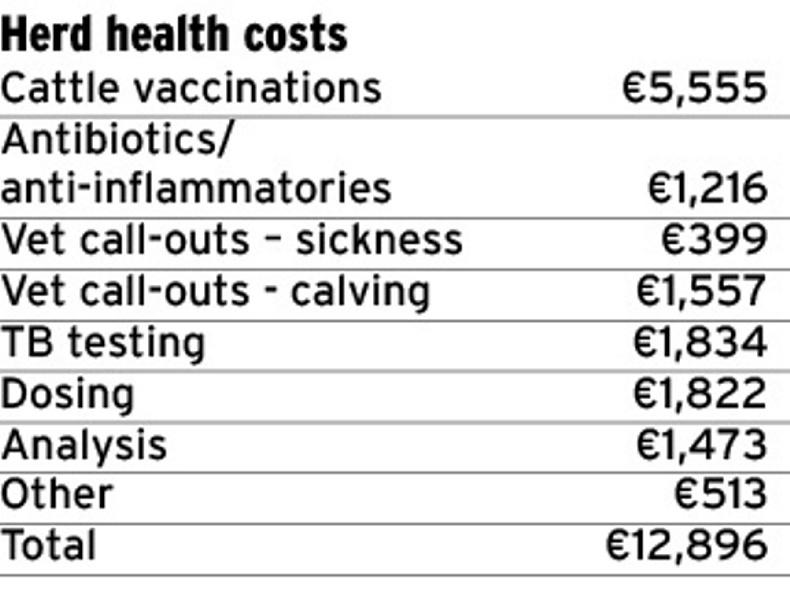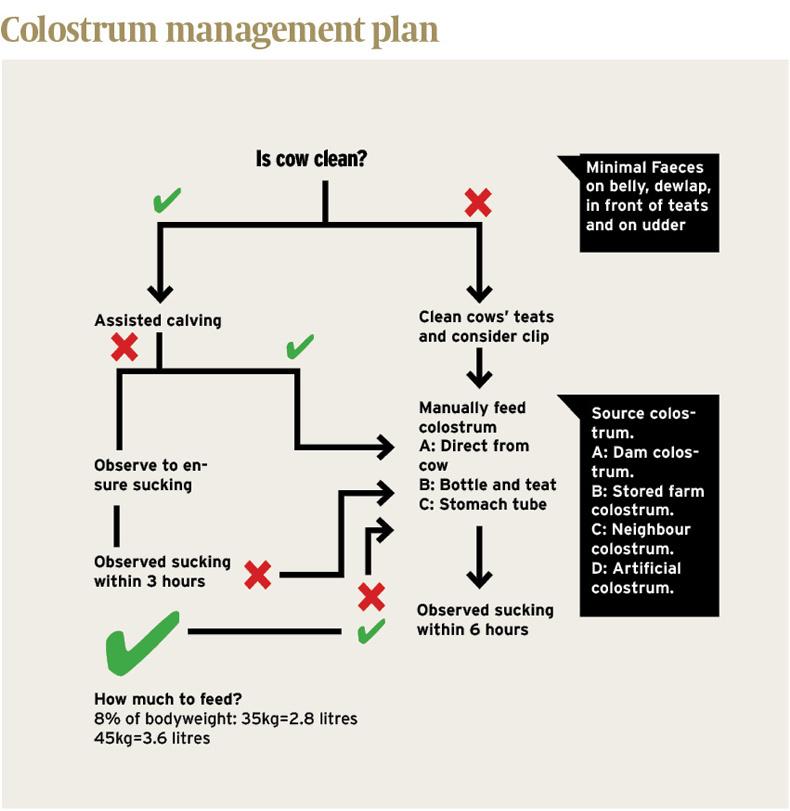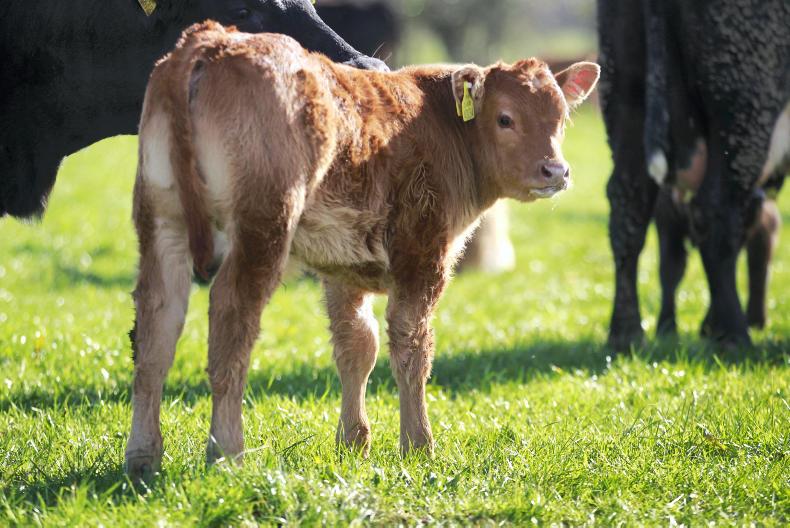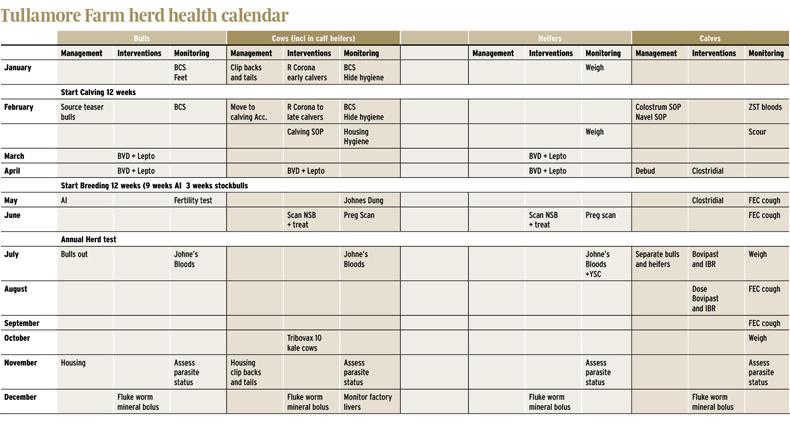As stocking rate and indoor stocking density increases on Tullamore Farm in the next few years, so too will disease pressure. While having a herd health plan won’t eliminate disease completely, it will hopefully move the farm towards disease prevention measures as opposed to fire brigade measures.
A decision was taken by the management team early in the project to limit the number of sources of stock brought on to the farm. In total, animals were purchased from 18 different herd numbers. All dairy calves were sourced on farms. All cows were tested clear of Johne’s disease before coming on to the farm. Cows were also TB tested within 60 days of coming on to the farm. Calves were the only exception; all calves were moved before six weeks of age, so no pre-movement test was needed. Stock were bought from herds of known herd health status to try and avoid any future health issues
Veterinary involvement
Our vet on Tullamore Farm is Donal Lynch, who has a practice four miles from the farm. He has been very much involved with planning the health side of the farming system. Donal is consulted regularly via a phone call or the farm’s WhatsApp group. The health plan was drawn up by Donal, the farm manager and myself. It looks at areas like ventilation, nutrition, vaccinations and also has clearly outlined protocols for e.g. colostrum management so there is no confusion as to what is required on the farm.
Biosecurity
Foot dips are placed at the point of entry to the farm and are cleaned out and topped up on a weekly basis. All visitors are asked to dip prior to entry. Farm staff are provided with wellingtons and wet gear. As many of the people involved with the farm are also farming in their own right at home, we need to be careful that there is no cross contamination of clothing etc. Boundary hedges have all been made stock proof with fences along with a hedge separating the farm and any neighbour’s cattle or sheep.
Biocontainment
While keeping disease out of the farm is important, so too is minimising the impact sick animals have on the rest of the herd. An isolation pen is currently being constructed. This is an existing shed on the yard periphery and will be used to house sick animals. Cleanliness and good hygiene are very important in minimising disease spread on the farm. Adequate bedding at lambing and calving is important. Keeping the dairy calves separate to suckler calves minimises the disease challenge for both. We have taken a prevention is better than cure route on the farm which will hopefully pay off long term.
Vaccinations
The suckler herd is being vaccinated against scour. This was completed in year one, with good results, and it was decided to continue this year for the whole herd. Other vaccinations include two shots of Lepto and BVD for cows (this will return to one shot in 2018), IBR,RSV, PI3 and clostridial vaccines for calves. Vaccination makes up the largest portion of the bill for 2017. Scour vaccine is costing €10/cow and is adding €1,000 to the overall bill. This is the only vaccine that would be seen as optional. Breeding and pneumonia vaccines are seen as critical.
Dosing
This included a fluke and worm dose to all cows in 2017. This was completed as a once-off to make sure no fluke came on to the farm. Blood and faecal samples taken this winter indicate no requirement to dose for fluke or worms in cows. Lice and worm treatments for all calves are included in this section.
Vet call-outs
Call-outs for sickness were quite low in 2017, with eight calls to the farm for sick animals. There were more calving call-outs than we would have liked. This was due to an issue with a bull which was used on some two-year-old calving heifers, with four call-outs to this batch.
Analysis
As this was the first year of the project, some extra analysis was undertaken to make sure there were no issues with Johne’s, Neospora etc.
Faecal samples were taken from calves during the summer months to determine dosing required and blood samples were taken from cows indoors to highlight any mineral deficiencies. Analysis costs are hugh but will reduce in 2017
Antibiotics and anti-inflammatories
The antibiotic usage on the farm is quite low, with a total bill in 2017 of €1,216. This was generally around calving time with antibiotics given to some cows which had very difficult calvings. Other issues included some lame calves during the summer months and a calf with a slight chill when housing started.
The table above outlines the herd health calendar for the year on Tullamore Farm. This acts as a reminder on a monthly basis as to what actions are required for that month
The schematic above right outlines a colostrum management plan on the farm. There is a huge emphasis placed on getting enough colostrum into calves within two hours of birth.
Herd health is all about making a practical plan between the farmer and his vet. Both need to have a good working knowledge of the management and objectives of the farm. We generally divide the plan into a number of headings:
1 Calf and young stock

A good start is the most important driver of future health of an animal. Attention to detail around calving time is important, hygiene, colostrum and cow management are key. The difference in viability between a big calf that had a hard calving and an easy calved calf is enormous, not to mention the future fertility of the cow. Hygiene is probably the biggest issue with calf scour, the main killer of neonatal calves. We need to ensure calves get colostrum before their intestine gets contaminated with faecal material from the cow or environment. We have all seen calves sucking dung hanging from a cow’s dewlap before he finds her teat.
2 Fertility
Getting more cows in calf quicker is a key driver of profitability on any breeding farm. Nutrition, heat detection, bull management and AI management are the major contributing factors. The objectives of the farm are key here whether we want to produce E and U grade bulls for the export market or replacement heifers for the national suckler herd. If we use AI we can select different bulls to match the positive attributes of certain cows.
3 Nutrition
Well-fed animals are more resistant to disease and perform better through milk/calf production or weight gain. Nutrition will include grass management and silage along with concentrates as required to supplement energy and protein. Minerals need to be factored in here also and supplementing method will vary from farm to farm. Getting silage tested for feed values and mineral levels is fundamental to making a winter nutrition plan while monitoring body condition and weight continually allows us to respond quickly to inadequate performance.
4 Environment and housing
Animals need a clean dry place to lie and shelter from adverse weather but plenty of fresh air movement to minimise the disease load in the environment, while having access to food and water. The more we make our sheds like a sheltered field the better. Poor ventilation is one of the big contributing factors to respiratory disease in cattle. Respiratory disease is the single biggest cause of disease in cattle over six months old.
5 Biosecurity, bioexclusion and biocontainment including Infectious disease and parasites
Keeping disease out is the best option but often not fully achievable. Once disease is on a farm, we need to minimise the spread and effects. Management practices along with planned vaccination programmes are fundamental here. It is important to use the right product at the right time to minimise stress on the animals.
A herd health plan is a continually evolving management tool that needs to be adaptable to changing conditions and challenges on an individual farm. We continually monitor for new or emerging problems on the farm and respond to control these as quickly and effectively as possible.
Every farm will also have some specific disease control measures for individual challenges that they face, such as Johne’s disease.
All of these areas come together and interact in the discussion between the farmer and vet to develop a workable herd health plan to drive health and profitability on farm.






 This is a subscriber-only article
This is a subscriber-only article





 Click for full-size calendar
Click for full-size calendar




SHARING OPTIONS: